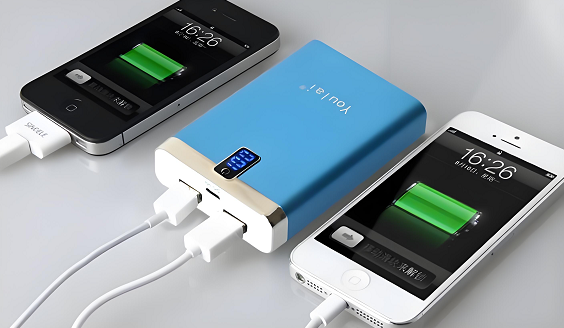As the most mainstream energy storage device at present, lithium batteries are widely used in various electronic devices such as mobile phones, laptops, mobile power supplies, electric vehicles, etc. However, lithium batteries of different devices show obvious differences when charging. These differences are not only due to the characteristics of the battery itself, but also closely related to the design logic of the charger. This article will analyze the core differences between different devices charging lithium batteries from the dimensions of charging method, protocol support, and safety protection.

I. Charging mode: constant current and constant voltage are the basis, and the details are different.
The standard charging process of lithium batteries is divided into two stages: constant current charging and constant voltage charging: the initial stage is fast charging with constant current. When the voltage rises to the rated value (such as 4.2V or 4.35V, depending on the battery type), it switches to constant voltage mode, and the current gradually decreases until it is fully charged. However, different devices have derived segmentation solutions based on this:
Mobile phone/laptop charger: pursuing a balance between efficiency and safety. Taking mobile phones as an example, mainstream chargers support fast charging protocols such as PD, QC, and FCP. The current in the constant current stage can reach 2A-5A (such as Xiaomi 18W fast charging), and the built-in chip monitors the voltage in real time to avoid overcharging. Some high-end models also support dynamic power adjustment, such as automatically reducing the current in low temperature environments to protect battery life.
UPS lithium battery/electric vehicle lithium battery: more focused on stability. UPS lithium batteries mostly use dedicated chargers. The current in the constant current stage strictly matches the battery capacity (such as 1C current, that is, 10A charging for 10A batteries), and the voltage accuracy is controlled within ±0.05V to prevent long-term overcharging from causing battery cell aging. However, electric vehicle lithium batteries (such as lithium iron phosphate) have a large number of battery packs in series, so the charger needs to have a balanced charging function to ensure that the voltage of each battery cell is consistent.
Mobile power supply (power bank): flexible adaptation to multiple devices. Taking the Xiaomi 10000mAh mobile power bank as an example, the single-port output supports 14.4W fast charging, and the dual-port output automatically distributes 5V/2.4A current. You can also double-click the button to turn on the 2-hour low-current mode, which is specially designed for charging low-power devices such as Bluetooth headsets and bracelets to avoid high current shock.
II. Protocol support: from "universal compatibility" to "exclusive optimization"
The charging protocol compatibility of different devices directly affects the charging speed and safety:
Mobile phone charger: deeply bound to brand characteristics. Apple iPhone relies on PD protocol (9V/2.22A), Huawei/Honor supports SCP high-voltage fast charging (10V/4A), and OPPO/VIVO uses VOOC low-voltage direct charging (5V/6A). If a third-party charger wants to achieve fast charging, it needs to have a built-in corresponding protocol chip (such as Zhirong SW3518S supports multiple protocols), otherwise it can only charge slowly at 5V/1A.
Dedicated lithium battery charger (such as 18650 charger): focus on a single model. This type of charger (such as the Narid dual-slot charger) usually has a fixed output of 4.2V/1A, only supports cylindrical lithium batteries (18650, 21700, etc.), is not compatible with NiMH batteries or other battery types, and lacks complex protocols, suitable for small devices such as flashlights and e-cigarettes.
Laptop charger: High power and anti-interference are equally important. Due to the large battery capacity (50Wh-100Wh), an input of more than 20V/3.25A is required, and the charger has a built-in EMI filter circuit to prevent high-frequency interference from affecting the motherboard. Some thin and light notebooks support the PD protocol and can be used as an emergency mobile phone charger, but the charging speed is far slower than the original adapter.
III. Safety protection: from "basic protection" to "intelligent monitoring"
Lithium batteries are sensitive to overcharging, overcurrent, and high temperature, and the protection mechanisms of different devices vary significantly:
Mobile phone charger: multiple hardware protections. Including overvoltage protection (OVP), overcurrent protection (OCP), short circuit protection (SCP), such as Xiaomi chargers add thermistors, automatically cut off the power when the temperature exceeds 65℃; high-end models also support battery health detection, dynamically adjust the current during charging.
Mobile power: Take into account discharge safety. In addition to charging protection, it is also necessary to prevent overload during discharge. For example, the dual USB ports of Xiaomi mobile power have independent control circuits, and the single port output automatically slows down when it exceeds 2.4A to avoid overheating of the battery cell. At the same time, the soft pack structure of lithium polymer batteries is more impact-resistant than traditional 18650 batteries, reducing the risk of short circuits.
Electric vehicle lithium battery charger: strict voltage threshold control. The output voltage of lead-acid battery chargers is usually 2.4V/cell, while the charging cut-off voltage of lithium batteries (such as ternary lithium) is 4.2V. If the lead-acid charger is misused, the voltage will exceed the standard, causing bulging or even fire. Therefore, lithium battery chargers must have a built-in voltage identification module to refuse to charge non-matching batteries.
IV. Charging efficiency and scene adaptation
Speed difference: Mobile phone fast charging can charge to 50% in 30 minutes (such as iQOO 44W mobile power bank), while UPS lithium battery needs 4-6 hours of slow charging due to its large capacity (such as 100Ah); when the mobile power bank is self-charging, 18W input is more than 3 times faster than 5V/2A traditional input.
Environmental adaptability: In low temperature environment, mobile phone chargers will automatically reduce the current (such as Apple limits fast charging below 0℃), while electric vehicle lithium battery chargers may be equipped with heating modules to ensure normal charging at -20℃; at high temperature, the chargers of all devices will trigger temperature protection to avoid damage to the battery cells.
Summary: How to choose the charger correctly?
Prioritize original accessories: Original chargers have been optimized for specific purposes, and the protocol matching and safety protection are more perfect.
Pay attention to parameter matching: confirm whether the charger output voltage/current meets the battery specifications (e.g. 3.7V lithium battery requires 4.2V cut-off voltage), and avoid "high voltage charging low voltage" or "high current charging small battery".
Be wary of inferior products: cheap chargers may lack overcharge protection, and long-term use will shorten the battery life and even cause safety accidents.
The difference between different devices charging lithium batteries is essentially a balance between "efficiency, safety, and adaptability". Understanding these differences can not only give full play to the performance of the device, but also extend the life of the lithium battery - after all, the correct charging method is the best protection for the battery.




